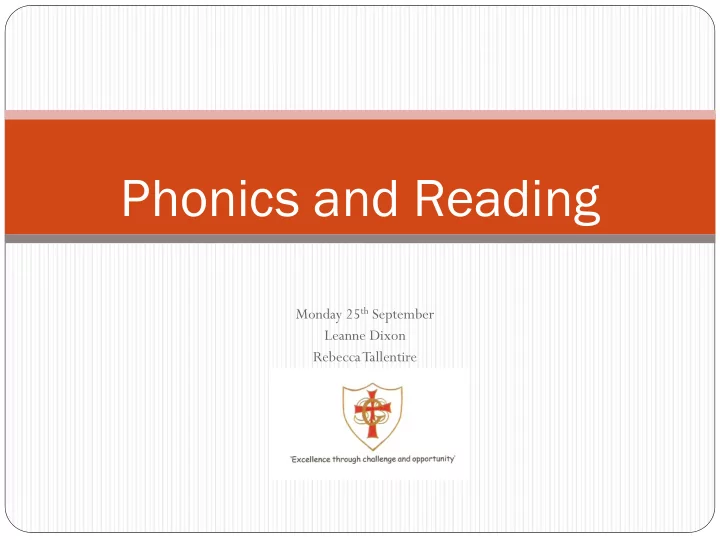

Phonics and Reading Monday 25 th September Leanne Dixon Rebecca Tallentire
The Objectives Of This Evening Positive behaviour Importance of phonics and reading in our school How your child learns to read How you can help your own child
Positive Behaviour Policy • Star of the Week • Stickers • Certificates • House points
Unacceptable behaviour is monitored through our traffic light system and we may inform parents if necessary Amber – moderate level Red – serious Level See behaviour policy for more information
What is Phonics? The sounding out of letters to help read and spell words correctly. Children are taught using the Jolly Phonics scheme. The teaching of Phonics is divided into phases. Reception Class – Phase 1, 2 and 3 Year 1 – Revision of Phase 3, 4 and introduction of Phase 5. Phonics test at the end of Year 1 to assess a child’s knowledge of phonics to date. Year 2 – Phase 5 and Phase 6 Phonics
Jolly Phonics – Phase 2 Teach 3 letters a week, each letter has an action. Letters are taught in this sequence. Please let child complete homework independently first (orange book) 1. s a t p 2. i n m d 3. g o c k 4. ck e u r 5. h b f, ff l,ll ss
Jolly Phonics – Phase 3 6 j v w x 7 y z, zz, qu 8 ch, sh, th, th ng 9 -ai, ee, igh, oa, oo, oo , ar 10 or, ur, ow, oi, ear, air, ure, er
Teaching of Phonics Phonics lesson – learn action, sound and how to write grapheme Initial letter sounds – I spy…identify first sound in a word. Sound talking cvc and vc words – Like a robot ‘s -i- t’ – adult models first Reading using sound buttons under words to encourage recognition of sounds and sounding out. Practise writing the letter using paintbrushes, glitter, glue and sand. Joining diagraphs (ch, th, ai etc)
Tricky words Tricky words are words that you can’t sound out and we simply need to remember the word! Reception Class need to be able to read and recognise a set of tricky words.eg I, the, no, go, to, we, he, she, me, be, my, you, they, her, all and are.
Reading Packet • Send home on a Monday – return Monday • 1X ORT • 2x “Sight” vocabulary or high frequency books • 1X Jelly and Bean (as the children are ready) • 1XSet of flash cards (to be kept at home)
Oxford Reading Tree • Reading for meaning scheme – each book tells a story that children can relate to • Learn some vocabulary for the scheme through flashcards • Look at picture clues/character expressions to understand the story • Repeated phrases
How you can help Practise action and sound from the beginning s not “suh”. Un -teach any bad habits (capitals) Encourage your child to build words ... eg i-t, c-a-n=can (adult first) Reinforce correct letter formation Practise flashcards including tricky words – (little but often is better). Begin to recognise letters and words in the world around them. Promote correct tenses within spoken language.
Characteristics of Effective Learning Playing and Exploring – “have a go” Playing with what they know Finding out and exploring Active Learning – Keep trying Being involved and concentrating Enjoy achieving and what they set out to Creativity and thinking critically Having their own ideas Making links Choosing ways to do things
Additional Information • PE days are Wednesday and Friday this term • Please feel free to send class fund termly (approximately £12) • Please, please return everything on a Monday!
Recommend
More recommend